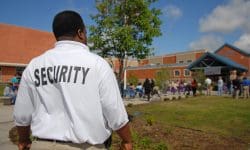Joplin District Rep: Don’t Use Hallways As Tornado Shelters
Had Joplin schools used hallways during the massive May 2011 tornado that struck Joplin, Mo., many lives would have been lost.
With spring just a couple of months away, campuses and districts should review their emergency preparedness policies and procedures involving severe weather.
The powerful tornado that struck Joplin, Mo., last May taught our district lessons that may bring far-sweeping changes to fundamental emergency procedures. As most of you remember, on May 22, 2011, Joplin was struck by a category five tornado, resulting in more than 160 deaths and 900 injuries. The tornado destroyed thousands of houses and severely damaged numerous apartments, businesses, school buildings and St. John’s Medical Center.
Fortunately, because this tragedy occurred on a Sunday afternoon, schools were not in session. Nevertheless, school hallway cameras and the recovery efforts of administrators provided the following impactful lessons.
Hallways Act as Wind Tunnels
For literally decades, Joplin Schools have pulled students out of classrooms and placed them in interior hallways during severe weather drills and warnings. Students were lined up against the hallway walls and instructed to assume the “duck and cover” position. May 22 has changed that practice forever.
Related Article: 14 Severe Weather Survival Tips
The video cameras in Joplin High School and East Middle School enabled administrators to see what would have happened in those designated shelter areas had students been there. Large debris, from street signs to car bumpers, was effortlessly tossed down the halls by the tornado. In some areas, classroom walls fell into the hallway. Each hallway literally became a wind tunnel.
Needless to say, many lives would have been lost in the school hallways had the storm came through during school hours. Equipped with that knowledge, Joplin Schools no longer utilize hallways – period.
The Federal Emergency Management Agency (FEMA) has since placed shelters at schools that were damaged in the tornado, but many other schools do not have FEMA shelters. In those buildings, the district has cleaned out old, musty basements that were being used for storage and made them into shelter areas for as many students as possible.
In the schools that needed additional shelter areas, or did not have basements, the district decided to use interior rooms – rooms that do not have any exterior walls. As a last resort, Joplin Schools will utilize rooms that may have an exterior wall, but do not have windows or exterior doors. In reviewing damaged schools, these areas fared much better than the hallways.
Sub-Par 2-Way Radio Systems Didn’t Work
Another impactful lesson from the Joplin tragedy surfaced during the initial stages of recovery and involved the need for better communication systems. Before the tornado, the school district relied on a dated, UHF, two-way radio system.The entire system consisted of one repeater. In fact, each school could communicate within the facility, but could not communicate from one school to another.
Not only was the existing system too limited, but standard practices involved administrators and staff members leaving assigned radios in the school building overnight. In the buildings that were struck by the tornado, all two-way radios were lost. Joplin administrators learned they needed two-way radio capabilities and practices that provided for communications from building to building across the entire district, day or night.
Phones Inoperable, But Text Messages Got Through
To make matters worse, in the immediate aftermath of the tornado, landline telephone service and all cellular phone carriers were inoperable. Some cellular carriers were not able to restore service for up to five days. In fact, landline telephone service was not restored for much longer than that. As a result, Joplin Schools had no way to communicate with staff from the command post following the disaster. It took the district a few days to realize that text messaging would work dependably even though cellular phone voice services did not.
Today, the city of Joplin and the schools that serve the community are still in recovery mode. Thanks to heroic efforts and a district-wide commitment to protect students and staff, numerous emergency preparedness changes have been made. Whether considering designated shelter areas or current communication capabilities, what will your response be to the lessons learned from this high-profile incident?
Paul Timm, president of RETA Security and Jim Hounschell is safety coordinator for the Joplin Schools. Both can be reached at info@retasecurity.com.
Related Articles:
- 14 Severe Weather Survival Tips
- What to Do When Severe Storms Strike
- Creating an Emergency Plan: 10 Ways to Tame the Beast
- Lessons Learned from the Joplin Tornado
- Joplin Tornado Assessment: Public Didn’t Heed Warnings
Note: The views expressed by guest bloggers and contributors are those of the authors and do not necessarily represent the views of, and should not be attributed to, Campus Safety magazine.
If you appreciated this article and want to receive more valuable industry content like this, click here to sign up for our FREE digital newsletters!
 Leading in Turbulent Times: Effective Campus Public Safety Leadership for the 21st Century
Leading in Turbulent Times: Effective Campus Public Safety Leadership for the 21st Century
This new webcast will discuss how campus public safety leaders can effectively incorporate Clery Act, Title IX, customer service, “helicopter” parents, emergency notification, town-gown relationships, brand management, Greek Life, student recruitment, faculty, and more into their roles and develop the necessary skills to successfully lead their departments. Register today to attend this free webcast!













